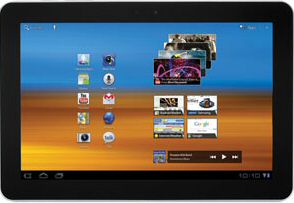It is safe to say that the Samsung Galaxy tablet hasn’t exactly been flying off the shelves a la the Apple iPad.
One major drawback of the first generation Samsung Galaxy Tab (based on Google’s Android software) that was launched in September last year was its 7-inch screen size.
Well, 7-inches seems might not too seem small compared to your neighbor’s better endowed 9.7-inch Apple iPad.
But remember screen size is measured diagonally and the Samsung Galaxy’ Tab’s 7-inch screen gave it only half the real estate of the iPad.
Indeed. When a friend visiting from India wanted to buy a tablet, we went over to Best Buy and played with both the Samsung Galaxy and the iPad. The Galaxy seemed so much smaller.
Although reviews for the Galaxy Tab were mostly favorable (plus it can play Flash unlike the iPad), sales of the Galaxy Tab so far are a small fraction of the iPad sales.
Clearly, the Apple iPad with its larger screen size and more applications has gobbled up the Tablet market.
 Samsung Galaxy Tab 10.1-inch Model
Samsung Galaxy Tab 10.1-inch Model
Now, Samsung is readying to launch a new version of the Galaxy tablet with a 10.1-inch screen.
Samsung plans to start selling Galaxy Tab 10.1 WiFi edition on June 8. The tablets will be available only at Best Buy’s Union Square store in NYC initially.
The limited availability is either a ploy to create buzz for the product through artificial shortages or, maybe just maybe, caused by a small initial supply of the product.
The 32GB version of the Galaxy Tab 10.1 WiFi edition costs $599 and the 16GB version will go for $499. Both versions are based on the Android 3.1 Honeycomb software.
Measuring an ultra-slim 8.6 millimeters in thickness, the Galaxy Tab 10.1 weighs 1.25 pounds (565 grams) and comes with an HD touchscreen display with WXGA 1280 x 800 resolution.
Big Question
The big question, of course, is whether the bigger screen size and other enhancements in the 10.1-inch model make it a significant alternative to the iPad, which has dominated the tablet market so far.
The short answer – No.
Besides the larger number of dedicated tablet applications for the iPad, Apple has also enjoyed all the advantages of being the first mover in the category and has recently released a new version, the iPad 2.
More than anything else, the biggest disadvantage the Samsung Galaxy has is the consumer perception of lack of ‘coolness’ attached to its product.
Apple has played a masterful marketing game here through skilful consumer manipulation here.
Plus, with the economy still depressed in the U.S. and elsewhere the market for Tablets is not really growing by leaps and bounds. Neither are people looking to upgrade the way they do with mobile phones.
JP Morgan hardware analyst Mark Moskowitz wrote the other day that tablet vendors other than Apple have already trimmed production plans in anticipation of lower demand for their gadgets. Moskowitz anticipates only 73 million tablets will be produced this year compared to his earlier forecast of 81 million units:
Beyond Apple’s iPad, there has not been another high-volume tablet offering to hit the market. Based on inputs from primary research contacts, the primary driver of the decline in pre-discounted build plans is the weak volume showing in the market from the non-Apple tablet hopefuls. Examples include Asustek’s Eee Pad Transformer, Motorola’s XOOM, RIM’s PlayBook, and Samsung’s Galaxy Tab.
For all of 2011, Moskowitz is predicting Apple will ship 29.6 million units of the iPad giving it 62% of the tablet market.
Bottom line, we don’t think the additional 3-inches will give Samsung much to crow about when it reports sales numbers for the new model of the Galaxy Tab six months from now.

You must be logged in to post a comment Login